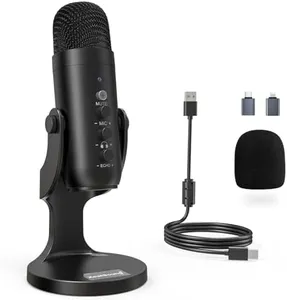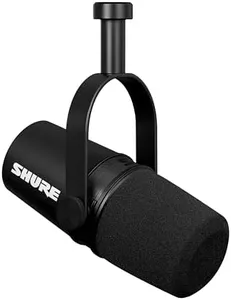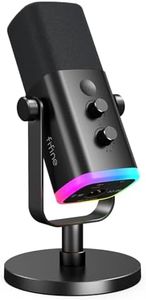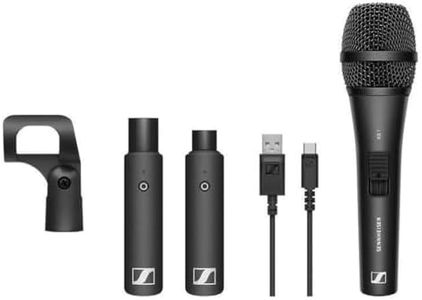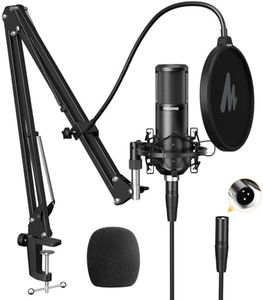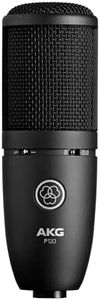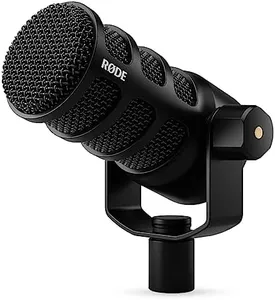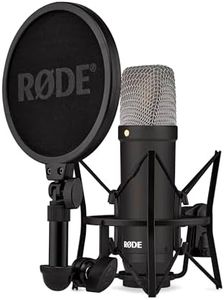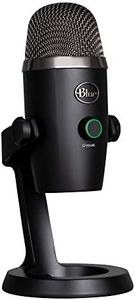10 Best Studio Microphones For Vocals 2025 in Canada
Our technology thoroughly searches through the online shopping world, reviewing hundreds of sites. We then process and analyze this information, updating in real-time to bring you the latest top-rated products. This way, you always get the best and most current options available.

Our Top Picks
Winner
ZealSound USB Microphone,Condenser Phone Computer PC Mic kit,Plug&Play Gaming Microphones for PS 4&5.Mic Gain&Volume Control,Echo &Mute Button for Vocal,Record,Streaming,Discord YouTube Podcast on Mac
The ZealSound USB Microphone is a condenser mic designed mainly for vocal use like streaming, podcasting, and gaming. It uses a cardioid (unidirectional) polar pattern, which helps reduce background noise by picking up sound mostly from the front, making it a good choice for focused vocal recordings. Its frequency response covers from about 80 Hz up to 20 kHz, which is suitable for capturing a natural vocal range with clarity. The mic sensitivity is decent at 125 dB, meaning it can detect quieter sounds without much distortion.
Connectivity-wise, this mic connects via USB, which makes it easy to plug into computers, laptops, and gaming consoles without needing extra audio equipment. Plus, it comes with adapters for iPhone, iPad, and USB-C devices, adding to its versatility for different setups. The plug-and-play nature means no complicated setup, which is great if you're new to recording.
Build quality is solid, featuring a metal body and a sturdy, anti-vibration stand that helps reduce unwanted noise from desk vibrations. It also includes handy controls on the mic itself, like gain (volume) adjustment, echo effect, mute button with an LED indicator, and headphone monitoring through a 3.5mm jack with zero latency. These features give you more control over your sound in real-time. Although it is not a professional studio-grade microphone, it offers a versatile option for casual and semi-professional users. Its frequency response, while good, is not as wide or flat as higher-end studio mics, so highly detailed vocal work may feel limited. Also, being USB-only means it won’t directly connect to traditional audio interfaces without adapters. This makes the ZealSound USB Microphone a user-friendly, well-built package with useful controls and noise reduction for gaming, streaming, and podcasting. It is an excellent choice if you want clear vocal recording with easy setup and good compatibility across devices, although those seeking the absolute best studio sound or XLR connectivity might want to look elsewhere.
Shure MV7X Microphone - XLR Only Pro Quality Dynamic Mic for Podcasting & Vocal Recording, Voice-Isolating Technology, All Metal Construction, Mic Stand Compatible, Optimized Frequency - Black
The Shure MV7X is a dynamic microphone designed specifically for vocals and podcasting, making it a solid choice for studio vocal recordings. It uses an XLR connection only, which means it’s meant to be connected to professional audio equipment rather than directly to a computer. This might require an audio interface, so it’s best suited for users who have or plan to get this gear. The microphone has a unidirectional (cardioid) polar pattern, helping to focus on your voice while reducing background noise—great for recording in less-than-perfect rooms. Its voice isolation technology and shock mount design further help minimize unwanted sounds, ensuring clear vocal capture.
The build quality is robust with all-metal construction, making it durable for regular use. The mic comes with a standard mic stand adapter, fitting most stands easily. Sensitivity and frequency response details are a bit limited publicly, but the mic is modeled after the well-regarded SM7B, known for its warm and natural vocal sound. One downside is it lacks USB connectivity, so it doesn’t offer plug-and-play simplicity for beginners without audio interfaces. Also, if you need multiple microphones for a podcast, the MV7X provides a budget-friendly, professional-sounding option.
In summary, the MV7X suits users focused on vocal quality and background noise rejection who have access to XLR audio gear and want a rugged, proven microphone design.
Shure SM58-CN Cardioid Dynamic Vocal Microphone with 25' XLR Cable, Pneumatic Shock Mount, Spherical Mesh Grille with Built-in Pop Filter, A25D Mic Clip, Storage Bag, 3-pin XLR Connector
The Shure SM58-CN is a dynamic microphone designed primarily for vocal use, making it a strong choice for both live performances and studio recording. Its cardioid polar pattern means it picks up sound mostly from the front, which helps isolate your voice while reducing background noise. The microphone’s frequency response is tailored to highlight vocals clearly, especially in the midrange, which gives your voice a warm yet crisp tone that sounds natural and present.
Being a dynamic mic, it’s less sensitive than condenser mics, which means it handles loud sounds well and is very forgiving in less-than-ideal recording environments. One important feature is its built-in spherical mesh grille and pop filter, which minimize unwanted breath sounds and plosives, making your recordings cleaner without extra accessories. The SM58-CN connects via a standard XLR cable, which is preferred for professional audio setups, though it requires an audio interface or mixer to connect to computers.
Its robust metal body and proven shock mount system make it extremely durable—perfect if you plan to travel or perform live frequently. The package also includes useful accessories like a 25-foot XLR cable, mic clip, and storage bag, adding good value. Being a dynamic mic, it may not capture the finer details and brightness that condenser microphones offer, so it might not be the best for very detailed studio vocal work. Also, it’s wired only, so it lacks the convenience of USB connectivity for plug-and-play use with computers. This makes the SM58-CN an excellent, reliable vocal microphone well-suited for singers who want solid sound quality and durability, especially in live or versatile studio settings.
